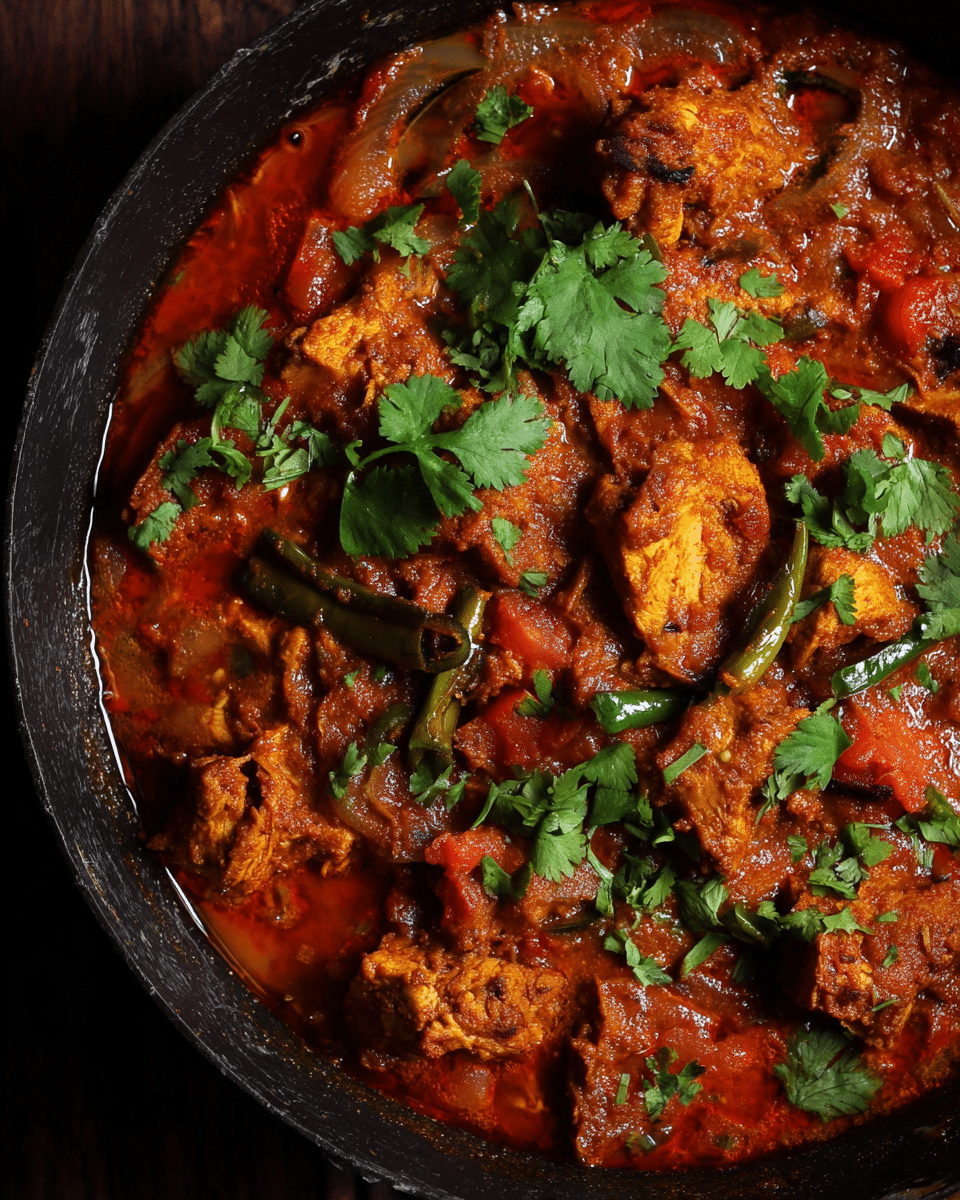Kosha Mangsho, a traditional Bengali-style braised stew, is an absolute treat for your taste buds. This rich, spicy vegan version uses soy curls or seitan as a substitute for meat, creating a hearty and flavorful dish perfect for any occasion. The aromatic spices, mustard oil, and tender soy curls come together in a deep, complex stew that will transport you straight to Bengal. Enjoy it with steamed rice or your favorite flatbread for a complete meal.
Whether you’re looking for a comforting dinner or exploring new flavors from Indian cuisine, Kosha Mangsho will soon become a favorite in your vegan recipe collection. The balance of spices and the satisfying texture of the soy curls make this stew an irresistible choice for those who crave bold flavors and wholesome ingredients.
Full recipe:
Ingredients:
-
1 ½ cups soy curls or seitan, rehydrated and chopped
-
2 tablespoons mustard oil
-
1 onion, finely chopped
-
2 tomatoes, chopped
-
4 cloves garlic, minced
-
1-inch piece of ginger, minced
-
2 tablespoons ginger-garlic paste
-
1 teaspoon turmeric powder
-
1 teaspoon red chili powder
-
1 teaspoon cumin powder
-
1 teaspoon coriander powder
-
1 cinnamon stick
-
4-5 green cardamom pods
-
2 bay leaves
-
1 teaspoon garam masala
-
Salt to taste
-
1 ½ cups water
-
Fresh cilantro for garnish
Directions:
-
Heat mustard oil in a large pot over medium heat. Add the bay leaves, cinnamon stick, cardamom pods, and sauté for 1 minute until fragrant.
-
Add the chopped onion and sauté until golden brown, about 5 minutes.
-
Add garlic, ginger, and ginger-garlic paste, and sauté for 2-3 minutes.
-
Add the chopped tomatoes, turmeric powder, red chili powder, cumin powder, coriander powder, and salt. Cook for 5-7 minutes until the tomatoes break down and form a paste-like consistency.
-
Add the soy curls or seitan and mix well, allowing them to absorb the flavors.
-
Add 1 ½ cups of water, stir, and bring to a boil. Reduce heat, cover, and simmer for 30 minutes, stirring occasionally.
-
Once the stew thickens, add garam masala and cook for another 5 minutes.
-
Garnish with fresh cilantro and serve hot with rice or bread.
Prep Time: 15 minutes | Cooking Time: 45 minutes | Total Time: 1 hour | Kcal: 300 kcal | Servings: 4 servings
The History of Kosha Mangsho
Kosha Mangsho is a hallmark of Bengali cuisine and a beloved dish in Bengali households. The preparation of this dish is closely linked to the region’s rich history and culinary traditions, which feature complex spice combinations. The Bengal region has a diverse food culture, heavily influenced by both vegetarian and non-vegetarian diets, as well as by its proximity to the sea, which makes seafood an integral part of the culinary landscape.
In its traditional form, Kosha Mangsho is made with mutton, which is slow-cooked with aromatic spices to achieve the perfect balance of flavors. The curry uses whole spices such as cardamom, cinnamon, and cloves, which create an aromatic base that infuses the meat with an irresistible depth of flavor. While meat dishes are prevalent in Bengali cuisine, the region also boasts a vibrant collection of plant-based meals, making this vegan adaptation of Kosha Mangsho a perfect example of how to enjoy traditional flavors in a modern, plant-based way.
Why You’ll Love Kosha Mangsho
One of the key reasons to try Kosha Mangsho is its unique, rich flavor profile. The combination of whole and ground spices brings a deep, savory complexity to the curry, making every bite flavorful and satisfying. The tofu, or any other plant-based meat substitute, absorbs the spices beautifully, offering a meaty texture without the actual meat. Moreover, the use of mustard oil adds a distinctly Bengali touch, which, while optional, imparts a unique taste that is commonly found in Bengali cooking.
This recipe is naturally gluten-free, and it can easily be made soy-free or nut-free with simple ingredient substitutions. It is perfect for those with dietary restrictions who do not want to compromise on flavor. Additionally, this dish is versatile, and you can use different plant-based proteins like soy curls, seitan, or even chickpeas, depending on your preferences or what you have available.
How to Make Kosha Mangsho
To make Kosha Mangsho, the first step is preparing the tofu, which acts as the “mutton” in this vegan version of the dish. Press the tofu to remove excess moisture, then cut it into bite-sized pieces. Marinating the tofu with yogurt and spices helps to infuse it with flavor and also gives it a slightly crispy texture when browned in the skillet. The key to perfecting this dish is in the caramelization of the onions. The onions should be cooked at high heat until they become golden brown and slightly charred, which adds a deep umami flavor to the sauce.
Once the onions are caramelized, the whole spices are added to the oil, releasing their aromatic oils and infusing the oil with intense flavor. After this, the ginger-garlic paste, ground spices, and tomato puree are added to create the base of the sauce. The tofu is then introduced back into the skillet, and everything is simmered together until the tofu is tender and the flavors have melded together beautifully.
For the perfect consistency, you can adjust the amount of water or stock, depending on whether you prefer a thicker or saucier dish. Kosha Mangsho is best served with a side of rice or Indian bread, allowing the flavorful sauce to be enjoyed with every bite.
Flavor Profile and Spices
The signature flavor of Kosha Mangsho comes from the careful combination of whole and ground spices. Whole spices like cardamom pods, cinnamon, and cloves provide a fragrant and bold foundation for the curry. Meanwhile, ground spices like coriander, cumin, and Kashmiri chili powder give it depth and heat. The addition of tomato puree and yogurt further enhances the richness of the sauce, making it velvety and smooth.
This dish is meant to have a balanced spice level, so you can adjust the heat according to your preference by choosing mild or hot dried chilies. If you’re sensitive to heat, you can also reduce the quantity of chilies used in the recipe.
What to Serve with Kosha Mangsho
Kosha Mangsho is best served with traditional sides like naan, flatbread, or rice. If you’re looking to make it even more authentic, you can serve it with luchi, a fried Bengali flatbread. The combination of the rich and spicy curry with these accompaniments creates a satisfying and filling meal.
Additionally, Kosha Mangsho pairs wonderfully with a cooling side like a cucumber salad or a refreshing yogurt-based side dish. The coolness of these sides helps balance the heat and spices in the curry, making for a well-rounded meal.
Tips for Perfecting Kosha Mangsho
To achieve the perfect Kosha Mangsho, there are a few key tips to keep in mind:
-
Brown the tofu well: When cooking the tofu, resist the temptation to stir it too often. Let it sit undisturbed for a couple of minutes to allow it to brown on one side, then flip it to brown the other side. This ensures a crispy texture and helps the tofu absorb the spices.
-
Caramelize the onions: The caramelized onions are essential for adding depth of flavor to the sauce. Be patient and cook the onions over medium-high heat until they turn golden brown. This may take some time, but it is well worth the effort.
-
Adjust the consistency: Depending on how saucy or thick you want your curry, adjust the amount of water or stock you add. If the sauce is too thick, you can always add a little more water to achieve the desired consistency.
-
Experiment with spice levels: If you’re sensitive to heat, reduce the amount of chili powder or use milder chili varieties. On the other hand, if you enjoy a spicier dish, feel free to increase the chili powder and dried chilies.
Storage and Leftovers
If you have leftovers, Kosha Mangsho can be stored in an airtight container in the refrigerator for up to three days. The flavors will continue to develop and intensify, making it even more delicious the next day. You can also freeze the curry for up to two months. To reheat, simply microwave it or warm it on the stovetop.
Conclusion
Kosha Mangsho is a flavorful and aromatic Bengali curry that is perfect for anyone looking to explore the rich and diverse world of Indian cuisine. Whether you’re a seasoned cook or just getting started, this dish is relatively easy to prepare and offers an authentic taste of Bengali food. By using tofu or other plant-based protein substitutes, you can enjoy the essence of this classic dish without compromising on flavor. This vegan version of Kosha Mangsho is not only delicious but also incredibly satisfying, making it an ideal choice for a cozy dinner or a special occasion. So, gather your ingredients and try your hand at making this traditional Bengali curry—you won’t be disappointed!






